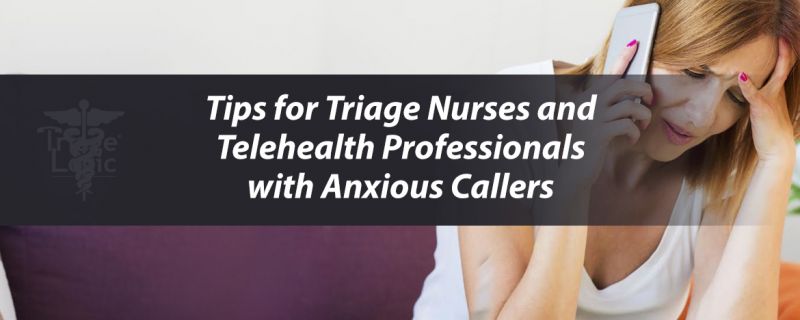Tips for Triage Nurses and Telehealth Professionals with Anxious Callers
Anxiety is as individual and personalized as pain is. Any medical professional, for instance a triage nurse, will tell you, “Pain is what the patient says it is.” Anxiety is similar, as it is hard to determine how an individual will react to situations. Sometimes, what the nurse may perceive as a small “inconvenience” is a major stressor for the patient. When triaging or evaluating patients over the phone or video, it is even more difficult to help anxious callers because the nurse is not present in the same room and cannot use body language for cues and aid. This is why it is important for triage nurses and telehealth professionals to know how to handle anxious callers. These tips will help triage nurses, office staff, and other medical professionals be better prepared for those calls.
Fact: Anxiety is a natural and normal response, particularly during illness or times of family stress.
Fact: 18% of all adults are affected by an anxiety disorder each year.1
Fact: Stress disorders occur twice as often in women as they do in men.1
Stress can become intolerable when a person is burdened with the extra strain of an illness. Everyone experiences times when stress levels seem unbearable. For callers, this is when they tend to become impatient, angry, and stop listening to any instructions. In telephone triage, nurses are in a unique position to be able to help some of these people regain their equilibrium.
Tips to Help Patients Feel They are Being Heard and Concerns are Being Answered
Tip 1: Listen. People want to know you are listening. Ask the patient, “How can I help you?” Then, listen fully to what they have to say. Just having someone listen to them helps the caller to disburse the anxious energy that has built up from the stress of the illness.
Tip 2: Set the tone. Never underestimate the soothing quality of introducing yourself and your discipline. Not only does it help to set a comforting tone, but it also helps build their trust in you. Keep your questions focused on the caller and their problem. Now, you are part of the solution that they are desperately seeking.
Tip 3: Offer solutions. Offer validation to the concerns the caller brings to you, then offer solutions they may not have thought of. By offering solutions that are new to the caller, it not only adds to their knowledge base, but it also empowers them with new information, which can be a great stress reliever.
Watch this quick video for additional tips on how to handle difficult callers.
Make Sure Triage Protocols are Being Followed
Patients that contact a telehealth line with stress related questions or symptoms can be complicated. For instance, nurses should never assume that a patient’s chest pain or shortness of breath is stress related. Following nationally recognized guidelines, like the Schmitt-Thompson protocols that TriageLogic uses, will help guide the triage nurse to ask the proper questions in order to rule out a medical emergency. Once the nurse has settled on the correct disposition, she can discuss ways to decrease the caller’s stress or anxiety issues.
Patients who talk with a TriageLogic nurse can be comforted by knowing that the information they provide is medically sound, evidence-based, and the dispositions are well supported by the physicians they are representing. Another advantage a telephone triage nurse brings an anxious caller is the personal and caring approach of a nurse ready and willing to listen.
Please feel free to leave us a comment in social media and share our blogs.
References
1 Anxiety Disorders. National Institute of Mental Health.
https://www.nimh.nih.gov/health/statistics/prevalence/file_148008.pdf






